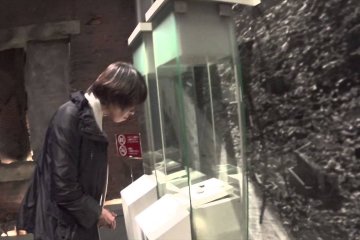
พิพิธภัณฑ์ต่อต้านสงครามที่มีชื่อเสียง
Tomoko Kamishimaพิพิธภัณฑ์อนุสรณ์สันติภาพฮิโรชิมาจัดแสดงสิ่งของมากมายที่เหลือจากการทิ้งระเบิดปรมาณู นอกจากนี้ยังแสดงบันทึกและภาพถ่ายต่างๆ แสดงให้เห็นความน่ากลัวของระเบิดปรมาณู

Hiroshima Peace Memorial Museum, located in southern Hiroshima, sits across from the Atomic Bomb Dome in the Peace Memorial Park. The museum houses information about Hiroshima’s history before and after the atomic bombing during WWII and aims to educate visitors about the infamous event and after-effects. Through education, the museum seeks to spread awareness about the inhumane nature of nuclear weapons and ultimately ban them. Its message is powerful: No More Hiroshimas.
To commemorate the 75th anniversary of the bombing of Hiroshima, a virtual tour of the museum has been released, as well as a Peace Park tour from the day of the anniversary event.
The east building contains three floors with permanent and temporary exhibitions. The second floor outlines the history of Hiroshima, while the third floor focuses on the aftermath of the bombing with video testimonies from bomb survivors, as well as displays about the dangers of nuclear weapons. The exhibits reflect the brutal truth of the bombing and the thousands of people who were killed and affected mentally and physically by the painful aftermath.
The permanent exhibits in the main building document the unimaginable horrors through items found after the bombing—a tricycle, a lunchbox, a school uniform—all once mundane objects whose meanings now tell of the instantaneous devastation of human actions. Photos line the walls, honestly displaying the aftermath.
Despite the unfiltered displays of war, the museum never wavers from its core message of remembrance, education, and future peace.
From Hiroshima Station, take a streetcar bound for Eba or Miyajima to Genbaku Domu Mae Station or take a streetcar bound for Hiroshima Port to Fukuro-machi Station (both about 15 minutes). From either station, the walk is about 7 minutes. If you want to bypass the streetcar, the walk from Hiroshima Station to the museum is about 35 minutes.

พิพิธภัณฑ์อนุสรณ์สันติภาพฮิโรชิมาจัดแสดงสิ่งของมากมายที่เหลือจากการทิ้งระเบิดปรมาณู นอกจากนี้ยังแสดงบันทึกและภาพถ่ายต่างๆ แสดงให้เห็นความน่ากลัวของระเบิดปรมาณู
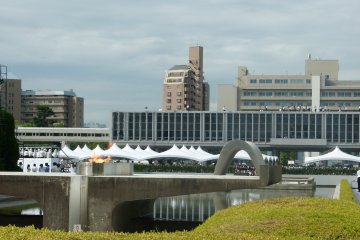
7 ข้อปฏิบัติสำหรับการใช้สัญญาณอินเทอร์เน็ต (WiFi) ฟรีภายในเมือง จากการสนับสนุนของเทศบาลฮิโรชิมา นอกจากนี้คุณยังเชื่อมต่ออินเทอร์เน็ตได้ที่ร้านกาแฟสตาร์บัค (ต้องขอรหัสผ่าน) หรือร้านกาแฟอื่นๆ ที่อยู่ใกล้เคียง ซึ่งโซนเหล่านี้คุณสามารถเชื่อมต่อสัญญาณอินเทอร์เน็ตได้อย่างง่ายดาย

Santiago Guesthouse Hiroshima เป็นที่พักฮิปๆสไตล์แบคแพคเกอร์ ผู้เข้าพักที่นี่ส่วนใหญ่เป็นวัยรุ่นต่างชาติที่แบคแพคในญี่ปุ่น ที่พักแห่งนี้ถือว่าราคาถูกมากถ้าเทียบกับโรงแรมชั้นกลาง หากลองเปรียบเทียบราคาแล้วถือว่าถูกกว่าเกือบครึ่งนึงเลยทีเดียว
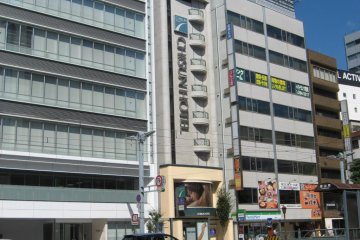
โรงแรมชิซุน ฮิโรชิม่าซึ่งตั้งอยู่ตรงกลางเมืองเป็นสถานที่ที่ดีต่อการพักอาศัยถ้าคุณกำลังวางแผนไปเยี่ยมชมเมืองที่โด่งดังระดับโลกแห่งนี้
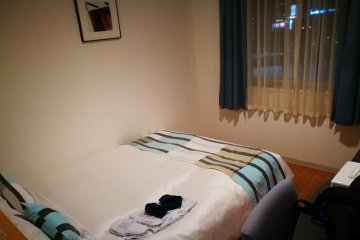
Hotel Flex เป็นโรงแรมที่ตั้งอยู่ริมแม่น้ำที่เกิดการบรรจบกันของแม่น้ำเคียวบาชิและแม่น้ำเอนโก วิวริมแม่น้ำถือเป็นจุดเด่นของโรงแรมแห่งนี้ สำหรับใครที่มาเที่ยวเมืองฮิโรชิมา แล้วอยากพักโรงแรมแบบสบายๆราคาเอื้อมถึง ขอให้ลองมาเข้าพักที่นี่ดู ชั้นล่างเป็นคาเฟ่ที่ถูกตกแต่งด้วยโทนสีสบายตา เข้ากับบรรยากาศริมแม่น้ำ ช่วงสายๆบ่ายๆ จะมีคนท้องถิ่นเข้ามานั่งพูดคุยจิบชา เพลินเพลินกับลมเย็นๆและบรรยากาศสบายๆ ห้องพักมีสิ่งอำนวยความสะดวกครบครัน แถมไม่ต้องเอาชุดนอนมาเพราะที่นี่มีชุดนอนลายน่ารักๆเอาไว้ให้ด้วย นอกจากนี้ เตียงยังมีขนาดใหญ่สำหรับนอนคนเดียวหรือสองคนได้อย่างสบาย ห้องค่อนข้างใหม่และสะอาด สามารถมองเห็นวิวยามค่ำคืนของเมืองฮิโรชิม่าได้ ข้างๆโรงแรมมีร้านสะดวกซื้อและร้านอาหารมากมาย ไม่ต้องกลัวหิว วิธีเดินทางมาก็สะดวก คือ เดินจากสถานีฮิโรชิมามาประมาณ 10 นาที แถวโรงแรมมีศูนย์เช่าจักรยานด้วย สามารถเช่าปั่นเล่นได้
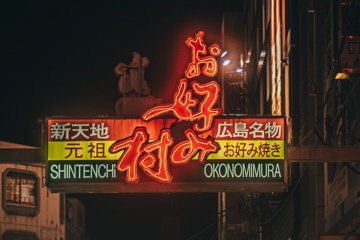
Okonomimura is a Hiroshima-style okonomiyaki theme park located in Shintenchi, Naka-ku, Hiroshima, near the east end of the Hondori shopping street. It has 24 okonomiyaki restaurants, each with a slightly different style and one different selection of ingredients. Okonomiyaki began in the pre-war period as a dish called "Issen Yoshoku" ("" Western food for a dime ""), which was very popular with common people. It consisted of a flour paste cooked with onions, dried shrimp, and spices. After the war, other ingredients such as cabbage, eggs, seafood, buckwheat and wheat noodles were used to improve the diet in these tough times. This is how today's Hiroshima-style okonomiyaki came about. [Photo: Victor Lee / CC BY-NC-ND 2.0]

โซบะจากแป้งบัควีดสไตล์ญี่ปุ่น พร้อมเครื่องเคียง และเครื่องดื่มเปิดให้บริการทุกวันตั้งแต่ 11:30 ถึง11:30 พร้อมเสิร์ฟอาหารถูกปากในราคาถูกใจ
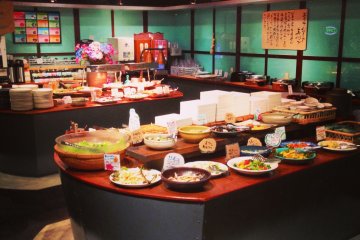
ผักสดๆจากฟาร์ม ชาบูชาบู และที่นั่งเหลือเฟือ... สิ่งเหล่านี้ทำให้ร้าน Roan เป็นร้านบุฟเฟต์ที่สูงกว่ามาตรฐานทั่วไป

"Carried to Hiroshima from Tinian Island by the Enola Gay, a U.S. Army B-29 bomber, the first atomic bomb used in the history of humankind, exploded approximately 580 meters above this spot. The city below was hit by heat rays of approximately 3,000 to 4,000°C, along with a blast wind and radiation. Most people in the area lost their lives instantly. The time was 8:15 a.m., August 6, 1945." This plaque on a downtown Hiroshima sidestreet marks the hypocenter of the Hiroshima atomic bombing, with the detonation of 'Little Boy' taking place 600 ft above this spot. Expect to see flowers or paper cranes left in memory at various times of the year.

พร้อมกับพิพิธภัณฑ์อนุสรณ์สันติภาพ โดมปรมาณู (Atomic Bomb Dome) ฮิโรชิมะได้กลายมาเป็นสัญลักษณ์ของสันติภาพ ที่มีนักท่องเที่ยวเข้าชมจากทั่วทุกมุมโลก ฮิโรชิมะได้กลับสภาพมาเป็นเมืองที่สวยงดงามอีกครั้งหนึ่ง และโดมปรมาณูก็เป็นเครื่องพิสูจน์ถึงความสามารถในการกลับคืนสู่สภาพเดิมของผู้คนในฮิโรชิมะ ยืนอยู่โดดเดี่ยว แต่รายล้อมด้วยอาคารตึกระฟ้าสมัยใหม่ มันเป็นสิ่งที่น่าชื่นชมและทำให้เรารู้สึกดีขึ้น ผมไปที่นั่นในวันฝนตกพรำๆ ของปลายเดือนพฤศจิกายน พร้อมๆ กับเด็กนักเรียนเป็นร้อยๆ คนที่มาทัศนะศึกษากับโรงเรียน สายฝนทำให้ทุกสิ่งทุกอย่างดูสดใสและมีชีวิตชีวา ความน่าสะพรึงกลัวยังคงมีให้เห็นอยู่ แต่ที่มีมากกว่าคือ ความหวัง
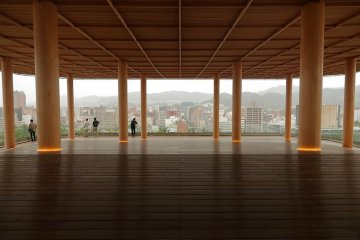
With its beautiful skylines and active waterways, Oizuru Tower offers its visitors a way to see all of that activity—day or night—unobstructed by glass or rails. The wooden floors and ceilings give off a gentle warmth and the pillars that support the ceilings also provide beams of light. Instead of glass or railings, guests can feel the Hiroshima air wash over them thanks to the stainless-steel net fence. With unobstructed views of Hiroshima, including the Peace Memorial Park and the Atomic Bomb Dome (and even Mount Misen of Miyajima on clear days), the tower offers viewers a way to feel at one with the city. Hiroshima Oizuru Tower is also home to an assortment of shops and cafés. Visit the first floor to find that special souvenir of one of Hiroshima’s local products at Hito to Ki. You’ll also find Hiroshima-style okonomiyaki in Akushu Café—including unique wrap-style okonomiyaki. On the 12th floor, you can also fold your own origami crane and leave it on the Oizuru Wall with your well wishes for the future. From the 12th floor to the 1st floor, there is a slide “cool-cool-cool” that runs alongside the spiral staircase. Why not try sliding your way down twelve floors—or just a couple, as you can exit in between floors. While you take a walk inside, browse the original comic created by Shuho Sato—manga artist of “Umizaru” and “Say Hello to Black Jack”—the works inside Oizuru Tower reflect on the theme of peace. No matter what you decide to do, you’ll be delighted by the spaces and experiences that you can create. Discover the past, present, and future of Hiroshima while you gaze out at this bustling city.